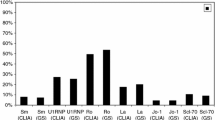Abstract
A new method is described to selectively determine the quantity of monomers and/or homopolymers of MRP8 and MRP14 and heteromers formed by two Ca2+-binding proteins of the S100 protein family. This detection system allows the discrimination of the type and phase of inflammatory processes in the synovial fluids and sera of patients with non-activated osteoarthritis (OAO) and activated osteoarthritis (OA) compared with patients with rheumatoid arthritis (RA).
Similar content being viewed by others
References
Odink K, Cerletti N, Brüggen J et al. Two calcium-binding proteins in infiltrate macrophages of rheumatoid arthritis. Nature. 1987;330:80–2.
Lagasse E, Clerc RG. Cloning and expression of two human genes encoding calcium-binding proteins that are regulated during myeloid differentiation. Mol Cell Biol. 1988;8:2402–10.
Sorg C. The calcium binding proteins MRP8 and MRP14 in acute and chronic inflammation. Behring Inst Mitt. 1992;91:126–37.
Hessian PA, Edgeworth J, Hogg N. MRP-8 and MRP-14, two abundant Ca2+-binding proteins of neutrophils and monocytes. J Leukocyte Biol. 1993;53:197–204.
Murao S. Two calcium-binding proteins, MRP8 and MRP14: a protein complex associated with neutrophil and monocyte activation. Acta Histochem Cytochem. 1994;27:107–16.
Heizmann CW. Calcium-binding proteins of the EF-hand-type and of the annexin family: a survey. In: Heizmann CW, ed. Novel Calcium-binding Proteins. Berlin, Germany: Springer Verlag; 1991:39–49.
Teigelkamp S, Bhardwaj RS, Roth J, Meinhardus-Hager G, Karas M, Sorg C. Calcium-dependent complex assembly of the myeloid differentiation proteins MRP8 and MRP14. J Biol Chem. 1991;266:13462–7.
Fagerhol MK, Dale I, Andersson T. A radioimmunoassay for a granulocyte protein as a marker in studies of the turnover of such cells. Bull Eur Physiopath Resp. 1980;16:237–81.
Berntzen HB, Munthe E, Fagerhol MK. The major leucocyte protein L1 as an indicator of inflammatory joint diseases. Scand J Rheumatol. 1988;76:251–6.
Sander J, Fagerhol MK, Bakken JS, Dale I. Plasma levels of the leucocyte L1 protein in febrile conditions: relation to aetiology, number of leucocytes in blood, blood sedimentation reaction and C-reactive protein. Scand J Clin Lab Invest. 1984;44:357–62.
Zwadlo G, Schlegel R, Sorg C. A monoclonal antibody to a subset of human monocytes found only in peripheral blood and inflammatory tissues. J Immunol. 1986;137:512–8.
Zwadlo G, Brüggen J, Gerhards G, Schlegel R, Sorg C. Two calcium-binding proteins associated with specific stages of myeloid cell differentiation are expressed by subsets of macrophages in inflammatory tissues. Clin Exp Immunol. 1988;72:510–51.
Mues B, Brisse B, Zwadlo G, Themann H, Bender F, Sorg C. Phenotyping of macrophages with monoclonal antibodies in endomyocardial biopsies as a new approach to diagnosis of myocarditis. Eur Heart J. 1990;11:619–27.
Delabie J, De Wolf-Peeters C, Van den Oord JJ, Desmet VJ. Differential expression of the calcium- binding proteins MRP8 and MRP14 in granulomatous conditions: an immunohistochemical study. Clin Exp Immunol. 1990;81:123–6.
Goebeler M, Roth J, Burwinkel F, Vollmer E, Böcker W, Sorg C. Expression and complex formation of S100-like proteins MRP8 and MRP14 by macrophages during renal allograft rejection. Transplantation. 1994;58:355–61.
Bhardwaij RS, Zotz C, Zwadlo-Klarwasser G et al. The calcium-binding proteins MRP8 and MRP14 form a membrane-associated heterodimer in a subset of monocyte/macrophages present in acute but absent in chronic inflammatory lesions. Eur J Immunol. 1992;22:1891–17.
Altaian RD. Criteria for classification of clinical osteoarthritis. In: Altman RD, Lascher D, editors, Litera Rheumatologica. Vol.13. Osteoarthritis: Is There a Potential for Chondroprotective Therapy? Basel: Eular Publishers; 1991:63–73.
Fassbender HG. Osteoarthosis — not simply a degenerative process. In: Fassbender HG, et al, editors, Articular Cartilage and Osteoarthrosis. Bern, Switzerland: Hans Huber Publishers; 1983:7–29.
Robins SP, Steward P, Astbury C, Bird HA. Measurement of the cross-linking compound, piridinolone, in urine as an index of collagen degradation in joint diseases. Am Rheum Dis. 1986;45:969–73.
Siebel MJ, Duncan A, Robins SP. Urinary hydroxy-pyridinium cross links provide indices of cartilage and bone involvement in arthritic diseases. J Rheumatol. 1989;16:964–70.
Saxne T, Heinegard D. Involvement of non-articular cartilage as demonstrated by release of a cartilage specific protein in rheumatoid arthritis. Arthritis Rheum. 1989;32:1080–6.
Goldberg RL, Huff JP, Lenz ME, Glicksman P, Katz R, Thonar EJ-MA. Elevated plasma levels of hyaluronate in patients with osteoarthritis and rheumatoid arthritis. Arthritis Rheum. 1991;34:799–807.
Mehraben F, Finegan C, Moscowicz RW. Serum keratin sulphate. Quantitative and qualitative comparisons in inflammatory versus non-inflammatory arthritides. Arthritis Rheum. 1991;34:383–92.
Dahlberg L, Ryd L, Heinegard D, Lohmander LS. Proteoglycan fragments in joint fluids. Influence of arthrosis and inflammation. Acta Orthop Scand. 1992;63:417–23.
Lagasse E, Weissman IL. Mouse MRP8 and MRP14, two intracellular calcium-binding proteins associated with the development of myeloid linage. Blood. 1992;79:1907–15.
Berntzen HB, Munthe E, Fagerhol MK. A longitudinal study of the leukocyte protein L1 as an indicator of disease activity in patients with the rheumatoid arthritis. J Rheumatol. 1989;16:1416–20.
Brun JG, Jonsson R, Haga H-J. Measurement of plasma calprotectin as an indicator of arthritis and disease activity in patients with inflammatory rheumatic diseases. J Rheumatol. 1994;21:733–8.
Brüggen J, Cerletti N. Distribution of the calcium-binding proteins MRP8 and MRP14 in normal and pathological conditions: relation to the cystic fibrosis antigen. In: Heizmann CW, ed. Novel Calciumbinding Proteins. Berlin, Germany: Springer Verlag; 1991:237–47.
Author information
Authors and Affiliations
Rights and permissions
About this article
Cite this article
Burmeister, G., Gallacchi, G. A selective method for determining MRP8 and MRP14 homocomplexes and heterocomplexes by sandwich ELISA for the discrimination of active and non-active osteoarthritis from rheumatoid arthritis in sera and synovial fluids. Inflammopharmacology 3, 221–230 (1995). https://doi.org/10.1007/BF02659119
Received:
Accepted:
Issue Date:
DOI: https://doi.org/10.1007/BF02659119




